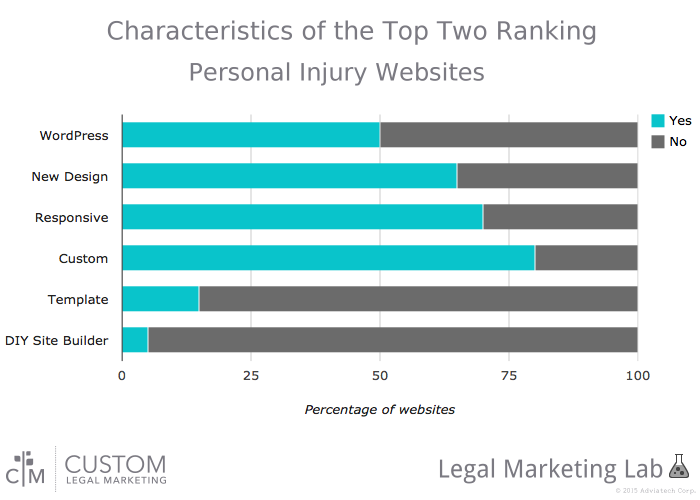In this study, we wanted to learn what attributes the top-ranking websites on Google share for America's most competitive legal keywords. We looked at the personal injury market (specifically, the car and auto accident subset) and conducted searches in various major cities across the country. We looked for answers to a number of questions.
Questions
- What percentage of highly competitive, top-ranking websites are using WordPress as their content management system (CMS)?
- What percentage of these websites have a newer design (less than two years old)?
- What percentage of these websites have a responsive design?
- How many of these websites are fully custom creations – that is, the law firm hired a design and development team to produce the website?
- How many of these websites are template-based creations – that is, the law firm used an off-the-shelf theme or template to develop the website?
- How many of these sites used a do-it-yourself (DIY) website builder like Squarespace, Wix or WordPress.com (the hosted version of the open source WordPress platform)?
Regions
We searched in major metro areas from Miami, Florida to Denver, Colorado and Cleveland, Ohio. Our searches extended all the way from California's southern tip to the northern reaches of Washington State. In short, we made sure to select a geographically comprehensive set.
We reviewed the top two naturally ranking law firm websites in each metro area we chose. Sometimes, the natural results ranked above the map, and sometimes they were the first sites listed in the map. If a directory or non-law-firm website was ranked first, we reviewed the next two law firm websites.
Results
WordPress CMS – 50%
Newer Site Design – 65%
Responsive – 70%
Custom – 80%
Template – 15%
DIY Site Builder – 5%
Details
WordPress: While WordPress-based websites comprise 50% of the top-ranking personal injury websites, there is no clear second place winner. The other half of the websites reviewed are using a proprietary CMS system offered by a development company, Drupal, static HTML (at least 10% are still using static websites) or an unknown CMS.
Newer Site Design: Using archiving and cache services, we were able to estimate the age of the designs we studied. This estimate is in no way related to the age of the actual domain name. Midwestern (excluding Chicago) and Southern city firms are most likely to have older website designs.
Responsive: We measured the percentage of sites with truly responsive designs against those with alternate design solutions or no solution at all. Afterward, we did check to see if the non-responsive sites had mobile-friendly versions available. Most of them did. In 2015, very few top-ranking personal injury websites are neither responsive nor mobile-friendly.
Custom: Most top-ranking injury law firms understand the importance of a custom website, and many have spared no expense to look their best. This is an investment that has obviously paid off, considering their prominent positions.
Template: Some law firms have websites (mostly WordPress-powered) that use ready-made themes. Templates offer a nice, simple way to build a website, but the results vary. A top-ranking website based on a ready-made theme is most likely to be found in a smaller metro area, like St. Paul, Minnesota or Cleveland, Ohio – cities that have fewer than 400,000 residents within city limits.
DIY Site Builders: Low-cost, do-it-yourself website builders do not frequent the top of search results – at least, not for highly competitive terms. Still, some lawyers have managed to get to the top with a DIY solution. In this 5% group, the most popular option is the hosted WordPress solution by Automattic. Based on the “premium” themes used by these sites, we can assume that these firms use the $300 per year Business Plan. These DIY sites consistently had two major traits in common:
- A Small Size: The biggest city in which we found a top-two website had just 380,000 residents within city limits.
- Bountiful Content: Top-ranking DIY sites have a lot of content. These top firms may have gone cheap on their website, but they are putting a lot of sweat equity into making it work.
So, if you live in a small enough region (and if you have the time and patience), it is possible to rank very well with a DIY solution.
Closing Remarks and Disclaimers
We have been using WordPress as our preferred content management system since 2008. Based on our results and comments, it may seem like we started this study with a pro-WordPress agenda. That's not the case. Over the past few years, we have noticed a lot more WordPress sites showing up in our clients' competitor reports, which raised the question, “How many law firms are also using WordPress for their websites?” The fact that websites using WordPress.com (the hosted DIY solution from Automattic) also showed up on our radar during this study was unexpected.
An interesting takeaway from the “semi-custom” template category: quite a few of these websites were built by companies that are advertising “custom websites” and even listing these modified-theme-based websites in their “custom” portfolios. If a company is selling you a fully custom website, it may be worth asking that they clarify the meaning of “custom.”
We chose to look at practices that deal with car accident injuries to give us a small but highly competitive pool of law firms to review. A more comprehensive look at every practice area and major city may or may not yield similar insight.
We close the report with a disclaimer. While it shouldn't affect the credibility of this report, some of the websites reviewed during this study belong to our clients. If a website ranked first or second for a Google search in their city, it didn't matter who built the website. We reviewed every top contender equally.
Shareable Graphic
